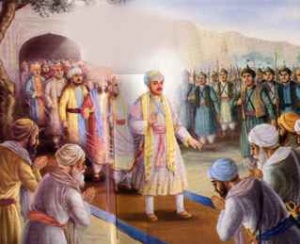Diwali
Also see Bandi Chhorh Divas
The story of Diwali is the festival of lights when, according to Indian lore, Lord Rama returned home after destroying the demon god Ravana who had taken away Rama’s wife, Sita.
Sikhs do not celebrate Diwali but celebrations take place at this time as Diwali coincides with the Sikh celebration of Bandi Chhorh Divas. This coincidence has resulted in similarity of celebrations amongst Sikhs and Hindus.
Sikhs celebrate Bandi Chhorh Divas to mark the return of the Sixth Guru, Guru Hargobind Ji, who was freed from imprisonment and also managed to release 52 Hindu Kings (political prisoners) at the same time from the famous fort of Gwalior by Emperor Jahangir in October, 1619.
And so the Kings/rajahs were freed and the Guru became known popularly as the "Bandi Chhor" (Deliverer from prison). He arrived at Amritsar on the Diwali day and the HarMandar (also known as the "Golden Temple") was lit with hundreds of lamps to celebrate his return and hence the day came to be known as the "Bandi Chhor Divas" (the day of freedom).
This Shabad is by Bhai Gurdas Ji: www.sikhitothemax.com
Diwali is celebrated because Guru Hargobind returned to Amritsar from being imprisoned. He had also freed 52 innocent Princes.
What happened was: Guru Hargobind, the sixth Guru, had been arrested for political reasons. The Mughal Emperor now decided that the religious fundamentalists that had been behind the martyrdom of the fifth Guru, Guru Arjun, were a greater threat to his throne. The Mughal Emperor, therefore, offered to free Guru Hargobind but Guru Hargobind refused to take his freedom until 52 princes who had also been detained for political reasons were also freed. The Emperor offered that all those who could hold the Guru's cloak could go free. 52 tassles were attached to the Guru's cloak and holding to his cloak all the 52 princes went free.
In addition to Nagar keertan (street procession) and Akhand paath (continuous reading of Guru Granth Sahib), Diwali is celebrated by:
fireworks display.
the Golden Temple is lit up.
| Vaars Bhai Gurdaas on Pannaa 19 |
| dheevaalee dhee raath dheevae baaleeani Lamps are lighted in the night of divali festival; thaarae jaath sanaath a(n)bar bhaaleeani fulaa(n) dhee baagaath chun chun chaaleeani theerathh jaathee jaath nain nihaaleeani har cha(n)dhuree jhaath vasaae ouchaaleeani guramukh sukhafal dhaath shabadh samhaaleean a |

